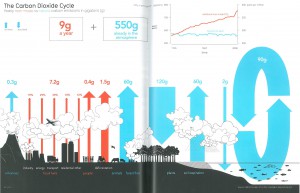2015 Project 1
How many resources do you use in your everyday life?
T he first assignment of the course is set as an accessible introduction to the course’s main issues. This assignment is divided in two parts, the first one consists of a short survey of students’ consumption of resources and the second part interrogates this consumption in relation to the students’ lifestyle.
he first assignment of the course is set as an accessible introduction to the course’s main issues. This assignment is divided in two parts, the first one consists of a short survey of students’ consumption of resources and the second part interrogates this consumption in relation to the students’ lifestyle.
After surveying their personal consumption of water, food and energy and looking at how much waste they produced for a week, students individually compiled their results in an online survey accessible by the whole class. Comparing their individual figures with their tutorial group and subsequently the whole class, small groups were assigned one of the resources and investigated how daily habits and way of life impact consumption patterns at different scales. After drawing simple hypothetical models, the students were asked to produce individual diagrams where not only the relationship between lifestyle and resource consumption and waste production was shown, but also where realistic changes in daily habits were suggested and their effectiveness measured. The format of the diagram was chosen specifically as an efficient yet graphically simple representational tool to convince an audience of a clear and straightforward message.
The pedagogic objective with this first exercise was to initiate a discussion on issues of sustainability from the immediate everyday environment of the students. Thus anchors the topic in their life experience rather than starting with broader problems which often seem unreachable or disconnected to the students.
This goal was achieved in two ways. First the personal survey conducted at class level and shared with all students allowed them to realize their implication as a group in broader processes of production and consumption of resources. Second their attempt to model this consumption according to potential changes of lifestyle and measuring their anticipated effectiveness, directly impacted their perception of sustainability as a problem to be solved by others.
Directly linking their daily habits with greater processes of production and long term effects of resource extraction allowed the instructors to achieve a more direct understanding of sustainability issues from students but also an active involvement in the modification of these processes.
In the following pages are displayed some examples of the students’ work. The initial survey was averaged for the whole class and integrated in the first half of diagram demonstrating how lifestyle and everyday decisions impact the consumption of resources and the production of waste. As a conclusion, the second half proposed alternatives to their present behavior balancing the pros and cons of such propositions often realizing some daily changes are more effective than others.
The process of making these documents was discussed in tutorials. The clarity of the message was mainly achieved through collages and simple graphs. These diagrams became supporting documents to a short final presentation on the specifically allocated resource which students had investigated.
